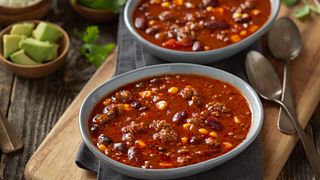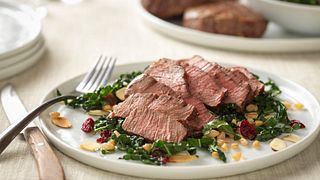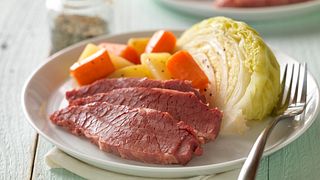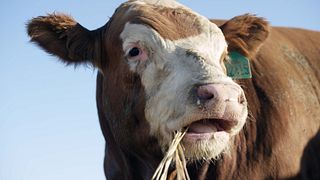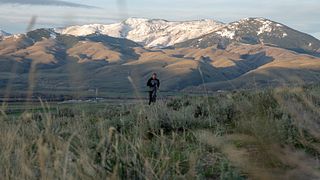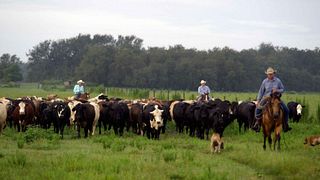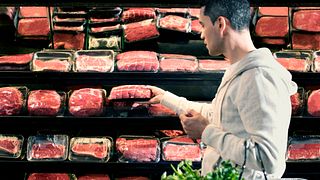COVID-19 and Beef Frequently Asked Questions
Q: Are animals responsible for COVID-19 in people?
- The predominant route of transmission of COVID-19 appears to be from human to human.1
- According to the CDC, there is no evidence that animals, including pets, play a significant role in spreading the virus that causes COVID-19.
- In isolated cases, it appears the virus can spread from people to animals, though further research is needed to understand how animals could be affected by COVID-19. Based on limited information available, the risk of the virus spreading between animals and people is considered low.9
- Current evidence suggests that the COVID-19 virus has an animal source. Ongoing investigations are important for identifying the animal source. To date, there is not enough scientific evidence to identify that source or to explain the route of transmission from an animal source to humans.1
Q: Can the bovine coronavirus vaccine be used to treat people?
- Bovine coronavirus is NOT the same as COVID-19.
- There is no evidence to suggest that the bovine coronavirus vaccine has any effect on humans or the COVID-19 strain. Vaccines are developed and tested for specific strains of viruses and species and should only be used according to label instructions. 2, 3
- The bovine coronavirus, as the name suggests, is specific to cattle and other domestic animals (i.e., horses, water buffalo, deer, elk, etc.). There is no cross protection between bovine coronavirus and COVID-19. 2, 3
- There are currently no antiviral drugs recommended or licensed by FDA to treat COVID-19, and there is no immunization available.4
Q: Will beef from cattle vaccinated for bovine coronavirus help build immunity against COVID-19?
- There is no evidence to suggest that this is the case.
- Even if a vaccine for bovine coronavirus is used in cattle, there is a 21-day or 60-day meat withdrawal period, depending on the vaccine, required prior to processing. This ensures the end product is safe for consumption and no medication would be present in the beef.5
Q: What impact is COVID-19 having on the beef supply?
- Cattle farmers and ranchers continue to produce high-quality beef.
- As COVID-19 continues to spread and impact economic activity, there is a great deal of uncertainty in terms of what it means for the beef industry, including on supply and demand.
- At this time, it’s impossible to measure the full effects of the virus or determine how it may continue to unfold.
Q: How does bovine coronavirus affect cattle?2, 3
- Bovine coronavirus is a cattle virus that farmers and ranchers have vaccinated their cattle against and managed for years. It can manifest as either a respiratory infection or gastrointestinal disease in cattle of all ages.
- Gastrointestinal signs include profuse diarrhea, dehydration, depression, reduced weight gain and anorexia.
- Bovine coronavirus has been associated with upper and lower respiratory tract disease and is a component of Bovine Respiratory Disease Complex. Signs may include respiratory distress, fever, nasal discharge, and coughing.
- Like other viral infections, other factors can influence an animal’s risk of infection and its ability to overcome the infection. These include host factors such as immunologic status or coinfections with a secondary bacterial infection and environmental factors such as extreme cold or hot temperatures.
Q: How do farmers and ranchers care for the cattle if they are sick with bovine coronavirus?5
- Farmers and ranchers use a variety of tools, including vaccines, good nutrition programs, low-stress handling, and proper housing to keep animals healthy.
- If necessary, antibiotics may be a tool that farmers and ranchers use to treat an animal.
- Beef farmers and ranchers work with veterinarians and animal health experts to ensure antibiotics are used responsibly.
- The beef community has significantly invested in educational programs, like Beef Quality Assurance and research to maintain high standards of animal care and health, including continuously improving the stewardship of antibiotics used in cattle.
Q: What is Beef Quality Assurance (BQA)?5
- Developed in 1991, Beef Quality Assurance (BQA) is a voluntary certification program that provides the U.S. beef industry with a consistent set of animal welfare standards and best practices.
- The BQA program exemplifies what beef farmers and ranchers have always cared about – a commitment to caring for their animals and providing families with the safest and highest-quality beef possible.
- Consumers can feel good knowing there’s a national program in place that sets consistent animal welfare and care standards across the beef industry. The result is wholesome safe, high-quality meat.
- More than 85 percent of the beef supply in the U.S. comes from farms and ranches that adhere to BQA standards and guidelines, and this number continues to increase monthly.
- The BQA program is nationally coordinated by the National Cattlemen’s Beef Association (NCBA), a contractor to the Beef Checkoff.
Q: Can I become sick with COVID-19 from food?
- USDA is not aware of any reports at this time of human illnesses that suggest COVID-19 can be transmitted by food or food packaging. However, it is always important to follow good hygiene practices (i.e., wash hands and surfaces often, separate raw meat from other foods, cook to the right temperature, and refrigerate foods promptly) when handling or preparing foods.6
According to the World Organization for Animal Health (OIE), meat from healthy livestock that is prepared and served in accordance with good hygiene and food safety principles remains safe to eat.1
Q: Are meat products compromised by COVID-19?
- USDA is not aware of any reports at this time of human illnesses that suggest COVID-19 can be transmitted by food or food packaging. However, it is always important to follow good hygiene practices (i.e., wash hands and surfaces often, separate raw meat from other foods, cook to the right temperature, and refrigerate foods promptly) when handling or preparing foods.6
According to the World Organization for Animal Health (OIE), meat from healthy livestock that is prepared and served in accordance with good hygiene and food safety principles remains safe to eat.1
Q: Are food products produced in the United States a risk for the spread of COVID-19?
- There is no evidence to suggest that food produced in the United States can transmit COVID-19.6
- According to the World Organization for Animal Health (OIE), meat from healthy livestock that is prepared and served in accordance with good hygiene and food safety principles remains safe to eat.1
Q: Can I get sick with COVID-19 from touching food, the food packaging, or food contact surfaces, if the coronavirus was present on it?
- Currently there is no evidence of food or food packaging being associated with transmission of COVID-19. Like other viruses, it is possible that the virus that causes COVID-19 can survive on surfaces or objects. For that reason, it is critical to follow the 4 key steps of food safety — clean, separate, cook, and chill.6
Q: If an inspector or worker in a meat processing plant became infected with coronavirus, would the meat produced at that facility be safe to eat?
- Public health and food safety experts do not have any evidence to suggest that COVID-19 can be transmitted by food or food packaging. FSIS in-plant personnel who are ill with COVID-19 or any other illness will be excluded from work activities that could create unsanitary conditions (coughing or sneezing on product). COVID-19 is thought to spread mainly from person to person through respiratory droplets that can land in the mouths or noses of people who are nearby.1, 6
Q: Can companion animals spread COVID-19?
- Currently, there is no evidence to suggest that animals infected by humans are playing a role in the spread of COVID-19. Human outbreaks are driven by person to person transmission.1
- Studies are underway to better understand the susceptibility of different animal species to the COVID-19 virus and to assess infection dynamics in susceptible animal species.
- Preliminary findings from laboratory studies suggest that, of the animal species investigated so far, cats are the most susceptible species for COVID-19, and, in a laboratory setting, cats were able to transmit infection to other cats. Ferrets also appear to be susceptible to infection but less so to disease. In the laboratory setting ferrets were also able to transmit infection to other ferrets. Dogs appear to be susceptible to infection but appear to be less affected than ferrets or cats.i1
- While there are currently no reports of cattle testing positive for COVID-19, now that COVID-19 virus infections are widely distributed in the human population there is a possibility for some animals to become infected through close contact with infected humans or a fomite that carries the virus for a short time.i1
- Further studies are needed to understand if and how different animals could be affected by COVID-19. State animal and public health officials are working closely with USDA and CDC to monitor this situation and will conduct additional testing if it is warranted.8
Q: Could a farmer or rancher with COVID-19 infect cattle with the virus?
- While there are currently no reports of cattle testing positive for COVID-19, now that COVID-19 virus infections are widely distributed in the human population there is a possibility for some animals to become infected through close contact with infected humans.1
- Further studies are needed to understand if and how different animals could be affected by COVID-19. State animal and public health officials are working closely with USDA and CDC to monitor this situation and will conduct additional testing if it is warranted.
- Anyone sick with COVID-19 should restrict contact with animals out of an abundance of caution during their illness, just as they would with other people. Although there have not been reports of animals beyond a tiger at the Bronx zoo becoming sick with COVID-19 in the United States, it is still recommended that people sick with COVID-19 limit contact with animals until more information is known about the virus. If a sick person must care for a pet or be around animals, they should wash their hands before and after the interaction.
Q: If cattle were to become infected with COVID-19, would beef from those animals be safe for human consumption?
- There are currently no reports of cattle testing positive for COVID-19.
- The USDA is not aware of any reports at this time of human illnesses that suggest COVID-19 can be transmitted by food or food packaging. However, it is always important to follow good hygiene practices (i.e., wash hands and surfaces often, separate raw meat from other foods, cook to the right temperature, and refrigerate foods promptly) when handling or preparing foods.6
- According to the World Organization for Animal Health, meat from healthy livestock that is prepared and served in accordance with good hygiene and food safety principles remains safe to eat.1
Q: Did animal agriculture contribute to the emergence of COVID-19?
- Current evidence suggests that the COVID-19 virus has an animal source. Ongoing investigations are important for identifying the animal source. To date, there is not enough scientific evidence to identify that source or to explain the route of transmission from an animal source to humans.1
- There is no evidence that cattle contributed in any way to the introduction of COVID-19 to humans.
- Coronaviruses that infect animals can sometimes be spread to people, but this is rare.9
Q: Could animal agriculture lead to future zoonotic-based pandemics?
- The best way to prevent future zoonotic-based pandemics is universal adoption of CDC’s One Health approach to disease control. One Health is a collaborative approach that works at local, national and global levels to recognize the interconnections between people, animals, plants, and their shared environments.
- The World Organization for Animal Health envisions One Health as a collaborative global approach for understanding risks for human and animal health. It builds on intergovernmental standards for One Health by publishing worldwide information on animal health collected through country reporting as well as a network of international disease experts and programs for strengthening the capacity of national veterinary service programs.
- Since 2012, NCBA has been involved with the activities of the One Health Academy in Washington, DC, which meets monthly to allow for information exchange and policy discussions related to One Health topics.
Q: Could a disease like COVID-19 originate in the U.S. in the future? How does the U.S. prevent zoonotic diseases?
- While One Health is an approach recommended globally by the United Nations and World Bank, in the U.S. both the USDA and CDC operate offices of One Health that provide interagency communication, education, and mitigation measures surrounding emerging and zoonotic diseases that could threaten the U.S. Both of these government agencies also collaborate on several well-established and important zoonotic disease surveillance programs.
- Throughout its history, the USDA has played a central role in protecting the health of U.S. animal agriculture through essential services involving risk assessment, port of entry inspection for imported animals and agricultural products, regulation of biological agents, development of animal vaccines, performing state-of-the-art animal diagnostic testing, and delivery of comprehensive disease surveillance, control, and eradication.
- The U.S. has a proven history of controlling zoonotic diseases as evidenced by measures put into place to address bovine tuberculosis and brucellosis in the 1900s. Today, the U.S. is considered essentially free of these diseases. 10, 11
- In the U.S., in addition to work done by USDA and CDC to address emerging and zoonotic diseases that could threaten human and animal health, the beef industry’s Beef Quality Assurance (BQA) program establishes that every member of the beef production system adheres to high standards of care in every aspect of production to deliver healthy animals and high-quality beef.
- All types of cattle operations work with a veterinarian to create a customized care plan for their animals. These high-quality care plans contribute to healthier animals with less risk of becoming ill by addressing nutrition, animal husbandry, vaccination plans to prevent disease and low-stress animal handling techniques.
Q: Do feedyards or other cattle operations where a large number of cattle are in close contact increase the likelihood of a zoonotic disease or outbreak originating and/or spreading?
- The U.S. is very good at controlling zoonotic diseases as evidenced by measures put into place to address bovine tuberculosis and brucellosis in the 1900s. Today, the U.S. is considered essentially free of these diseases.10, 11
- Programs like Beef Quality Assurance (BQA) provide a total quality assurance program that establishes that every member of the beef production system adheres to high standards of care in every aspect of production to deliver healthy animals and high quality beef.
- All types of cattle operations work with a veterinarian to create a customized care plan for their animals. These high-quality care plans contribute to healthier animals with less risk of becoming ill by addressing nutrition, animal husbandry, vaccination plans to prevent disease and low-stress animal handling techniques.
Q: Would reducing meat consumption lower the risk of future zoonotic diseases and pandemics?
- No. Whether for food or other purposes, interactions between animals and humans occur globally. The best way to prevent future zoonotic-based pandemics is universal adoption of a One Health approach to disease control. One Health is a collaborative approach that works at local, national and global levels to recognize the interconnections between people, animals, plants, and their shared environments.
For more FAQ related to access to food, critical infrastructure, food safety and other topics, visit https://www.usda.gov/coronavirus.
- https://www.oie.int/en/scientific-expertise/specific-information-and-recommendations/questions-and-answers-on-2019novel-coronavirus/ accessed March 16, 2020.
- Boileau, M. & Kapil, S. (2010). Bovine Coronavirus Associated Syndromes. Veterinary Clinics of North America Food Animal Practice. Mar 26(1): 123-46. doi: 10.1016/j.cvfa.2009.10.003.
- MacLachlan, N.J. & Dubovi, E.J. (2017). Coronaviridae. Fenner’s Veterinary Virology, 5th edition. (pp. 435-461). Elsevier Inc.
- https://www.avma.org/resources-tools/animal-health-and-welfare/covid-19 accessed March 16, 2020.
- https://www.bqa.org accessed March 16, 2020.
- https://www.usda.gov/coronavirus accessed March 16, 2020.
- https://www.aphis.usda.gov/aphis/newsroom/news/sa_by_date/sa-2020/ny-zoo-covid-19
- https://www.cdc.gov/coronavirus/2019-ncov/daily-life-coping/animals.html?CDC_AA_refVal=https%3A%2F%2Fwww.cdc.gov%2Fcoronavirus%2F2019-ncov%2Fprepare%2Fanimals.html
- https://www.aphis.usda.gov/animal_health/animal_diseases/brucellosis/downloads/bruc-facts.pdf
- https://www.aphis.usda.gov/aphis/ourfocus/animalhealth/animal-disease-information/cattle-disease-information/national-tuberculosis-eradication-program
